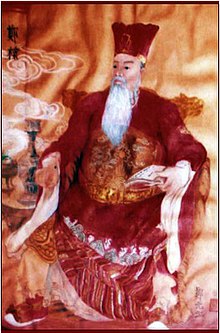Trịnh Kiểm
| Trịnh Kiểm | |||||||||||||
|---|---|---|---|---|---|---|---|---|---|---|---|---|---|
| Lord of Trịnh Clan Lord of Northern Vietnam |
|||||||||||||
 |
|||||||||||||
| Trịnh Lords | |||||||||||||
| Reign | 1545–1570 | ||||||||||||
| Predecessor | Military commander established | ||||||||||||
| Successor | Trịnh Cối | ||||||||||||
| Born | 1503 Thanh Hóa, Đại Việt |
||||||||||||
| Died | 1570 | ||||||||||||
| Spouse | Lại Thị Ngọc Trân | ||||||||||||
| Issue |
Trịnh Cối Trịnh Tùng 3 more sons and 2 daughters |
||||||||||||
|
|||||||||||||
| House | Trịnh clan | ||||||||||||
| Father | Trịnh Lâu | ||||||||||||
| Mother | Hoàng Ngọc Dốc | ||||||||||||
| Religion | Buddhism | ||||||||||||
| Full name | |
|---|---|
| Trịnh Kiểm | |
| Posthumous name | |
| Minh Khang Thái Vương (明康太王) | |
| Temple name | |
| Thế Tổ (世祖) |
Trịnh Kiểm (1503–1570) ruled northern part of Vietnam from 1545 to 1570. Trịnh Kiểm was the founder of the Trịnh Lords or House of Trịnh who ruled Dai Viet while a succession of figurehead Later Lê Emperors took the role as puppet government. During his rule, the war with the Mạc Dynasty continued. Although he was the de facto ruler of Dai Viet during his reign, he never claimed himself title of Lord, hence he is not the first official Trịnh Lord but his son Trịnh Tùng is the first. Later Trịnh Kiểm was posthumously proclaimed Trịnh Lord by his descendants.
Trịnh Kiểm claimed descent from Trịnh Khả, who was one of the top aides of Lê Lợi and later became the top official during the reign of child-king Lê Nhân Tông. His relationship to the General Trịnh who defeated a rebel army in 1511 and then led a rebellion of his own in 1517 is unknown. Also unknown is his relationship to Trịnh Duy Dai and Trịnh Duy Sản (two of the leaders of the first revolt against Mạc Đăng Dung).
A second revolt against Mạc Đăng Dung took place not long after Dung usurped the throne and proclaimed himself Emperor of Vietnam in 1527. This second revolt was led by Nguyễn Kim whose second-in-command was his son-in-law, Trịnh Khiêm (who married Kim's daughter Ngoc Bao). The second revolt allowed the Nguyễn-Trịnh army to capture the Western Capital (Tay Do) and enthrone Emperor Lê Trang Tông, in 1533.
The Nguyễn-Trịnh alliance sent a formal embassy to China that denounced the usurpation of Mạc Đăng Dung and asked for help. In 1536, the Chinese delegation concluded that Dung had usurped the throne of the Lê Emperors. After hearing the report, the Jiajing Emperor dispatched an army that arrived on the border of Vietnam in 1537. However, with protestations of loyalty to the Ming Dynasty and the offer of a piece of north Vietnam to the Chinese, Mạc Đăng Dung convinced the Chinese to leave. The official position of the Chinese government was that the Mạc Dynasty should rule in the north and the Lê government should rule in the south. The Nguyễn-Trịnh alliance refused to accept this settlement, continuing the war.
...
Wikipedia
